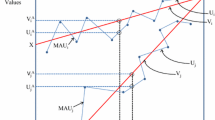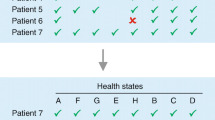Abstract
Multi-attribute utility theory (MAUT) provides a way to model decisions involving trade-offs among different aspects or goals of a problem. We used MAUT to model prostate cancer patients' preferences for their own health state and we compared this model to patients' global judgments of health state utility. 57 patients with prostate cancer (mean age = 70) at two Chicago Veterans Administration health clinics were asked to evaluate health states described in terms of five health attributes affected by prostate cancer: pain, mood, sexual function, bladder and bowel function, and fatigue and energy. Each attribute had three levels that were used to form three clinically realistic health state descriptions (A = high, B = moderate, C = low). A fourth personalized health description (P) matched the patient's current health. We first measured patients' preferences using time trade-off (TTO) judgments for the three health states (A, B, and C) and for their own current health state (P). The TTO for the patient's own health state (P) was standardized by comparing it to TTO judgments for states A and C. We next constructed a multi-attribute model using the relative importance of the five attributes. The MAU scores were moderately correlated with the TTO preference judgments for the personalized state (Pearson r = 0.38, N = 57, p < 0.01). Thus, patients' preference judgments are moderately consistent and systematic. MAUT appears to be a potentially feasible method for evaluating preferences of prostate cancer patients and may prove helpful in assisting with patient decision making.
Similar content being viewed by others
References
Keeney RL, Raiffa H. Decisions with Multiple Objectives: Preferences and Value Tradeoffs. New York: Cambridge University Press, 1993.
Elstein AS, Holzman RB, Ravitch MM, Metheny WA, Holmes MM, Hoppe RB, Rothert ML, Rovner DR. Comparison of physicians' decisions regarding estrogen replacement therapy for menopausal women and decisions derived from a decision analytic model. Amer J Med, 1986; 80: 246±58.
Casper GR, Calivitti A, Brennan PF, Overholt JL. Computer-Link: the impact of a computer network on Alzheimer's caregivers' decision-making con®dence and skill. Medinfo 1995; 8Pt 2: 1546.
Eriksen S, Keller LR. A multiattribute-utility-function approach to weighing the risks and bene®ts of phar-maceutical agents. Med Decis Making 1993; 13(2): 118±25.
Klein BE, Karlson TA, Rose J. An anatomic index for the severity of ocular injuries. European J Opthamo-logy 1993; 3(2): 57±60.
Bellamy CA, Brickley MR, McAndrew R. Measure-ment of patient-derived utility values for periodontal health using a multi-attribute scale. J of Clin Period-ontology 1996; 23(9): 805±809.
Hodder SC, Edwards MJ, Brickley MR, Shepard JP. Multiattribute utility assessement of outcomes of treatment for head and neck cancer. British J Cancer 1997; 75(6): 898±902.
Revicki DA, Simpson KN, Wu AW, LaVallee RL. Evaluating the quality of life associated with rifabutin prophylaxis for Mycrobacterium avium complex in persons with AIDS: Combining Q-TWIST and multi-attribute utility techniques. Quality of Life Res 1995; 4(4): 309±318.
Torrance GW, Feeny DH, Furlong WJ, Barr RD, Zhang Y, Wang Q. Multiattribute utility function for a comprehensive health status classi®cation system: Health Utilities Index Mark 2. Med Care 1996; 43(7): 702±722.
Kramer MS, Estazadi-Amoli J, Campi A. Tange SM, Drummond KN, Mills EL, Berstein ML, Leduc DG. Parents' versus physicians' values for clinical outcomes in young febrile children. Pediatrics 1994; 93(5): 697±702.
Holmes MM, Rovner DR, Rothert ML, Elstein AS, Holzman GB, Hoppe RB, Metheny WP, Ravitch MM. Women's and physicians' utilities for health outcomes in estrogen replacement therapy. J Gen Intern Med 1987; 2: 178±182.
Carroll JD, Green PE. Psychometric methods in mar-keting research: Part I, conjoint analysis. J Marketing Res 1995; 32(4): 385±391.
Green PE, Srinivasan V. Conjoint analysis in market-ing: New developments with implications for research and practice.J Marketing 1990; 43(4): 3±19.
Bennett CL, Chapman GB, Elstein AS, Knight S. A comparison of perspectives on prostate cancer: Anal-ysis of utility assessments of patients and physicians. European Urology 1997; 32: 86±88.
Bennett CL, Matchar D, Crawford D. Cost-e.ective-ness models of ¯utamide: Are they helpful to policy-makers? Cancer 1996; 9: 1854±1861.
Cassileth BR, Soloway MS, Vogelzang NJ, Chou JM, Schellhammer PD, Seidmon EJ, Kennealey GT, members of the Zoladex Prostate Cancer Study Group. Quality of life and psychosocial status in stage D prostate cancer. Qual Life Res 1992; 1(5): 323±329.
Calais da Silva F, Reis E, Costa T, Denis L, the Members of the Quality of Life Committee for the EORTC Genitourinary Group. Quality of life in pa-tients with prostatic cancer, Cancer 1993; 1(Suppl): 1138±1142.
Fossa SD, Aaronson N, Newling D, van Cangh PJ, Denis L, Kurth KH, de Pauw M, the Members of the EORTC Genitourinary Group. Quality of life and treatment of hormone resistant metastatic prostatic cancer. Eur J Cancer 1990; 1(12): 1133±1136.
Herr HW, Kornblith AB, Ofman UA. A comparison of the quality of life of patients with metastatic pros-tate cancer who received or did not receive hormonal therapy. Cancer 1993; 71(Suppl): 1143±1150.
Litwin MS, Hays RD, Fink A, et al. Measuring health related quality of life in men with prostate cancer. J Urology 1995; 152: 1882±1887.
Pedersen KV, Carlsson P, Rahmquist M, Varenhorst E. Quality of life after radical retropubic prostatec-tomy for carcinoma of the prostate. Eur Urology 1993; 4: 7±11.
Baron J.Thinking and Deciding. 2ndEd. New York: Cambridge University Press, 1994.
Chapman GB, Elstein AS, Kuzel TM, Shari® R, Na-dler RB, Andrews A, Bennett CL. Prostate cancer patients' utility for health states: how it looks depends on where you stand. Med Decis Making 1998; 18(3): 278±286.
Torrance GW. Utility approach to measuring health-related quality of life. J Chronic Dis 1987; 60: 593±604.
Payne JW Bettman JR, Johnson EJ. The Adaptive Decision Maker. New York: Cambridge University Press, 1993.
Stiggelbout AM, Kiebert GM, Kievit J, Leer JWH, Habbema JDF, deHaes JCJM. The utility of the time trade-off method in cancer patients: feasibility and proportional trade-off J Clin Epi 1995; 48: 1207±1214.
Stiggelbout AM, deHaes JCJM, Kiebert GM, Kievet J, Leer JWH. Tradeoffs between quality and quantity of life: Development of the QQ Questionnaire for cancer patient attitude. Med Decis Making 1996; 16: 184±192.
O'Leary JF, Fairclough DL, Jankowski MK, Weeks JC. Comparison of time-tradeo. utilities and rating scale values of cancer patients and their relatives: Ev-idence for a possible plateau relationship. Med Decis Making 1995; 15: 132±137.
Author information
Authors and Affiliations
Rights and permissions
About this article
Cite this article
Chapman, G.B., Elstein, A.S., Kuzel, T.M. et al. A multi-attribute model of prostate cancer patients' preferences for health states. Qual Life Res 8, 171–180 (1999). https://doi.org/10.1023/A:1008850610569
Issue Date:
DOI: https://doi.org/10.1023/A:1008850610569




